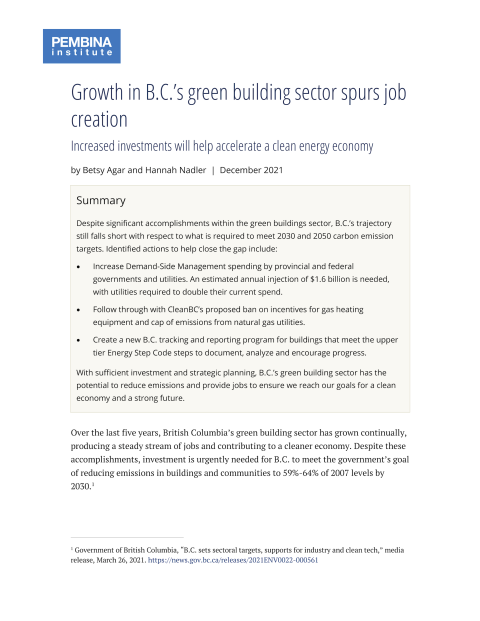Over the last five years, British Columbia’s green building sector has continually grown, produced a steady stream of jobs, and contributed to a cleaner economy. Despite these accomplishments, investment is urgently needed for B.C. to meet the government’s goal of reducing emissions in buildings and communities to 59%-64% of 2007 levels by 2030.
- Our updated British Columbia Green Buildings Map shows that green building certifications are on the rise, however we anticipate that our ability to continue tracking this sector will soon hit roadblocks.
- Green jobs are trending upward slightly. We estimate that 8-10 jobs are created for every $1 million spent on green building retrofits and new construction.
- Electrification is B.C.’s best path to decarbonizing its economy, but current and projected spending falls considerably short of what is needed to drive necessary growth in the workforce. Utilities need to increase their Demand side management (DSM) spends for incentives and fuel-switching programs.
- CleanBC’s recently released Roadmap to 2030 includes bold measures that will help propel the transition to low-carbon alternatives, while still allowing gas utilities to provide programs to help their customers save energy and money.
Identified actions to help close the gap:
- Create a new B.C. tracking and reporting program for buildings that meet the government’s upper tier Energy Step Code (ESC) steps to document, analyze and encourage progress.
- Increase DSM spending by provincial/federal governments and utilities. An estimated annual injection of $1.6 billion is needed, with utilities required to double their current spend.
- Follow through with CleanBC’s proposed ban on incentives for gas heating equipment and cap of emissions from natural gas utilities.
With sufficient investment and strategic planning, B.C.’s green building sector has the potential to reduce emissions and provide jobs to ensure we reach our goals for a clean economy and a strong future.







